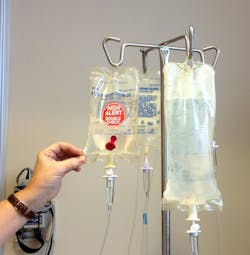Genomic markers identify which glioma patients derive benefit from chemotherapy
Specific genomic biomarkers can be used to identify glioma patients most likely to benefit from post-radiation chemotherapy and serve as a significant predictor of overall and progression-free survival, according to new data published by researchers at The Ohio State University Comprehensive Cancer Center – Arthur G. James Cancer Hospital and Richard J. Solove Research Institute.
These new findings provide practice-changing data to guide treatment of brain tumor patients diagnosed with gliomas based on their underlying genomic characteristics, said Principal Investigator Arnab Chakravarti, MD, who also is chair of the Department of Radiation Oncology at Ohio State. Researchers reported their findings in the Journal of Clinical Oncology.
Previous studies of molecular-based prognostic classification for low-grade gliomas led the World Health Organization (WHO) in 2016 to reclassify central nervous system tumor grades, a system that categorizes tumor risk groups based on both anatomical and molecular features. However, follow-up research on the prognostic value of this grading system in clinical outcomes has been limited by the relative rarity of the disease and by having limited access to significant patient populations.
For this new retrospective study, researchers sought to determine the prognostic and predictive impact of the WHO-defined molecular subgroups and corresponding molecular alterations of 106 patients who received treatment as part of the NRG Oncology/RTOG 9802 phase III clinical trial. These patients had both comprehensive molecular profiling data based on the WHO-defined molecular groups and information about clinical outcomes available for review.
“Our study is the first prospective, randomized international phase III clinical study to demonstrate that the World Health Organization (WHO) molecular glioma subgroups that are inclusive of the mutant version of the Isocitrate dehydrogenase (IDH 1/2) gene appear to derive greatest benefit from the addition of PCV-based chemotherapy to radiation versus radiation alone," Chakravarti said.
“PCV-based chemotherapy regimens can be highly effective but can at the same time harbor significant risk for the occurrence of serious toxicities for high-risk, low-grade glioma patients. Hence, it is absolutely critical to identify upfront which of these patients would normally serve to derive greatest survival benefit from a PCV-based chemotherapy regimen while sparing others, who do not derive such survival benefits, from its potentially harmful side-effects,” he added.
Researchers specifically investigated the presence IDH 1/2 gene mutations by themselves in the tumors and their association with progression-free survival and overall survival among patients. They determined that IDH 1/2 gene mutations were significant predictors of both overall and progression-free survival after adjustment for clinical variables and treatment.
“This new data removes at least some of the controversy about management of low-grade gliomas, primarily related to accurate predictive biomarker classification and treatment selection. We can now definitively use molecular biomarkers to identify people who are likely to reap the greatest benefit from post-radiation chemotherapy and spare those who are unlikely to garner any additional benefit from unnecessary treatment.”

